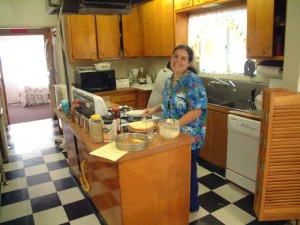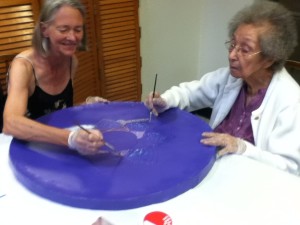The post How to Choose a Memory Care Facility or Alzheimer’s Assisted Living Facility in San Diego appeared first on Lakeside Manor.
]]>What is Alzheimer’s Assisted Living and what does it offer?
Alzheimer’s assisted living is a type of housing for elderly residents who have Alzheimer’s or Dementia. The staff undergoes special training in order to specifically work with Alzheimer’s and Dementia patients.
Alzheimer’s assisted living facilities offer:
- A safe and stable environment for your loved one
- A secured facility to ensure your loved one does not leave the establishment
- A specialized staff that can deal with difficult situations and behaviors, such as wandering
- Activities for each person living in the facility, structured to reflect their daily routines that they established during their life
- Indoor and outdoor activities
- Medical and personal care
- Regimented dining schedules
- Music and Craft Therapy
Why choose Alzheimer’s Assisted Living?
One of the most important benefits of Alzheimer’s assisted living is knowing your loved one is in good hands and their quality of their life isn’t reduced due to their condition. This may be an even bigger concern if your loved one suffers from memory loss. Naturally, you want to find a San Diego memory care facility that has the knowledge and compassion to work with people who are suffering from Alzheimer’s disease.
At a specialized Alzheimer’s assisted living facility that has years of experience with memory loss patients, you can be assured that your loved one will be attended to by trained professionals who understand the needs of an Alzheimer’s disease patient.
Finding the right San Diego Alzheimer’s Assisted Living Facility
If you decide that an Alzheimer’s assisted living is the right choice for your loved one, start by making a list of the facilities that you want to visit. These resources might help you find some:
- The Choose Well San Diego website has a list of facilities in San Diego County that you can sort with a lot of different ways, like license, city, zip code and capacity.
- Conduct a search on Google using keywords like “dementia care facilities San Diego.”
- You can also find information by consulting friends and neighbors.
- Keep in mind; all these facilities are licensed and regulated by each state.
Make sure all Alzheimer’s assisted living facilities in San Diego on your list are licensed.
Finding out more about the facilities
After you decide on a few Alzheimer’s assisted living facilities you are comfortable with, call them and ask a few general questions about their facilities. Ask about the programs they offer for their seniors, how willing they are to accommodate dietary restrictions, what are the residents’ most popular activities and other questions that will help you get a better feel for the environment.
If you are still interested in the facility after the call, ask for some information to be mailed to you, such as brochures, a price list, map and the rights and rules of the residents. Don’t forget to ask about any documents that will need to be signed upon admittance and of course, the contract. You need to review them on your own time before you sign anything.
After you receive all the materials, review them carefully and write down your questions or concerns. Strike out the places that don’t meet your criteria.
If your loved one can choose for herself or himself, make sure to include them in the process.
Visiting a San Diego Alzheimer’s Assisted Living Facility
Now, you have a list of the places you want to visit, so book appointments for tours. Make sure to take your loved one with you so they can take part in the decision process.
Have your questions and the material that was sent to you in hand and make sure to get as much information as you can from the tour.
Your first visit is important
When you get there, a guide will show you around the facility, explaining the programs the offer and how your loved one will benefit from their stay there. Keep in mind that the person talking to you is an employee and their job is to turn you into a customer.
Ask to meet other members of the staff and a few residents as well. When you talk to them, pay attention to their body language, if they are happy and comfortable working or living there. Find out how long the staff members have been working in this facility. Long-term employees are unlikely to be unhappy or bad at their jobs. Ask the residents how they feel about the place, what they do for entertainment and if they like the staff.
Apart from asking questions, pay attention to how people behave when they think you are not looking. If someone told you that they are happy in this facility but when you turned around their facial expression said otherwise, you should reconsider.
Also, check if the facility is clean and tidy. Are there any weird smells? Is the building well maintained? Are the staff’s uniforms clean? What about the residents? They should be clean, without emitting any bad odors and, most importantly, look (and be) well cared for.
Make sure to pay them one more unannounced visit after a few days. You may find out important information by making that second visit.
How you feel is important too
Asking questions and noticing behaviors is crucial in deciding on a facility, but it’s very important to bring your own feelings into this decision.
Be aware of how you feel when you are on the facility’s premises; do you feel comfortable, is this really a safe place for your loved one? Trust your gut–it’s usually right.
Aarp.org has a very helpful checklist you might want to print out and take with you.
Deciding on a facility and signing the contract
After visiting the facilities, reviewing all the information you received and having your questions answered, choosing your favorite memory care facility in San Diego is the most important step. The contract you will sign is the legal document that states what kind of care will be provided to your loved one, regardless of what was promised verbally or mentioned in the brochures. Make sure everything you want is written down; the more details, the better. Compare the information you received before with what is in the contract and pay close attention to fees, services provided and discharge policies.
Tips
- Make sure you understand what the contract says. Ask questions and get answers before signing anything.
- Ask about anything not included and make the changes you want.
- Don’t sign the contract until you see everything you want in it.
- Take the contract with you and review it with other family members and make sure to consult a lawyer.
The cost of a San Diego Alzheimer’s Assisted Living Facility
Paying for a high-quality Alzheimer’s assisted living center can be quite costly. Before you decide on searching for a facility for your loved one, make sure that you (or them) can afford it long-term. Expect that you might need to pay for extra services as needed and don’t forget that the price might go up due to the increase of the standard cost-of-living.
At Lakeside Manor, our San Diego Alzheimer’s Assisted Living Facility offers a caring, nurturing environment for our residents. Take a look at our testimonials and contact us for more information and a chance to see for yourself! Our staff will be happy to answer any questions or needs you might have.
The post How to Choose a Memory Care Facility or Alzheimer’s Assisted Living Facility in San Diego appeared first on Lakeside Manor.
]]>The post Memory Care or Assisted Living? Making the Best Choice for Mom or Dad appeared first on Lakeside Manor.
]]>
What is Assisted Living?
The primary definition of assisted living is a long-term senior care option that offers supportive aid, health services, and housing. Essential services often include transportation, medical management, and 24-hour emergency care. Mom or Dad will be able to ask the staff for assistance with daily tasks.
Depending upon personal preferences, budget, and layout of the specific home, residents in assisted living may enjoy a private room or share space in an apartment. Assisted living centers should be licensed by the state in which they are situated, yet they are not federally regulated.
What is Memory Care?
A memory care facility is intended specifically for patients with dementia, Alzheimer’s disease, and other memory disorders. Sometimes these homes are referred to as SCUs – special care units. Typically, memory care units provide supervised services around the clock, and they are often located on a separate floor or area of a residential center. The staff is specially trained and qualified to assist and nurture people with cognitive problems or dementia, often through customized guided activities.

A unique and necessary feature of memory care is the high level of security, which is designed to meet the specific needs of patients with Alzheimer’s and dementia. Wandering is minimized, and the layout is usually easy for residents to navigate. Another benefit of memory care that is growing in popularity is outdoor gardens, which have been shown to enhance the lives of Alzheimer’s patients dramatically.
The state must license memory care facilities, and they are also regulated in 23 states by SCU disclosure rules, which require them to inform the public about their special services.
Which Basic Services Are Provided by Both Assisted Living and Memory Care?
- Emergency call buttons and systems
- Exercise/health programs
- Medical care access
- 24-hour staff and security
- Housekeeping and laundry
- Social programs
- Daily meals
- Transportation
Do Memory Care and Assisted Living Cost the Same?
A number of factors determine the cost of every senior care facility. The size of the rooms, shared versus private space, geographic location, and available services all play a role in the final expense. However, when comparing the price of memory care versus assisted living, there are additional considerations.
Assisted living is typically charged on a monthly basis, which includes room and board with two or three meals a day. Some of these homes provide laundry and housekeeping in the base rate, while others tack on cleaning services as an additional charge. In comparison, memory care also offers specialized nursing, which makes the cost considerably higher than assisted living. However, the final fee of both places depends upon the patient’s insurance plan or veterans’ benefits.

How to Make Your Final Decision?
Ask yourself the following questions:
1. How Active Is Mom or Dad?
Some seniors are very involved in social and physical activities. They regularly participate in golden-age exercise groups, games, and art classes, as well as attend lectures and cultural performances. However, when it comes to bathing, dressing or preparing food, they may not be entirely independent. Sometimes this is because their mobility is impaired due to age or they have mild dementia. In general, these individuals are well suited for assisted living.
2. Does Mom or Dad Have a Memory Problem?
If your mother or father has progressive memory impairment, their needs will typically be more complex and specialized. They may require assistance that goes way beyond help with hygiene and getting dressed, and it can be unsafe for them to live without enough supervision. In this case, memory care may be the most appropriate living solution.
3. Does Your Loved One Wander?
It is usual for patients with Alzheimer’s or dementia to wander off at any hour of the day or night. They are often found walking the halls or streets, lost and confused. This practice increases their risk of injuries due to slips and falls. Memory care homes are designed to address this problem with advanced security systems and staff that keeps an eye on patients at all times.

What is Your Final Step?
There is no substitute for seeing things for yourself. After you contemplate and have answers to the issues above, it is advisable to visit some local facilities that satisfy your parent’s requirements. Prepare in advance by compiling a list of what you want to know; the Alzheimer’s Association has a helpful, comprehensive checklist for choosing residential care, which you can adapt to meet your needs.
Ideally, you should first visit alone to narrow down the options, and then bring Mom or Dad for a follow-up trip. They may have their own questions and concerns that you didn’t consider. Also, you can observe how they fit in with the crowd, as well as how the staff interacts with them. These are all clues that can help you match your mother or father to the type of senior care that’s best for them.
Last, but not least, no matter which setting you select – do not feel guilty about putting your parent in assisted living or a memory care facility. This decision is challenging and filled with emotion for all children. However, it helps to keep sight of the end goal – to optimize the quality of life for your loved one by keeping them comfortable, safe, and as independent as possible. For more information and assistance with your decision, please contact our friendly and compassionate staff at Lakeside Manor.
The post Memory Care or Assisted Living? Making the Best Choice for Mom or Dad appeared first on Lakeside Manor.
]]>The post 10 Facts You Need To Know About Memory Care appeared first on Lakeside Manor.
]]>1. A Collaborative, Advanced Approach to Memory Care
First of all, a memory care center needs to provide services that are up-to-date with all of the latest advances in dementia care. A collaborative approach is a must, since coordinating care for your loved one involves a wide range of people: your loved one, the care team, and the family members involved.
2. A Well-Trained, Adequate Number of Staff Members
Not counting housekeeping or dietary personnel, a memory care facility should ensure that the ratio of caregivers—aides and nurses—to patients is at least one to five, explains Lisa Esposito, RN, staff health writer for U.S. News. In addition, these caregivers should keep current with all the latest developments in Alzheimer’s treatments, dementia treatments, and in geriatric care in general. With that knowledge, caregivers can tell the difference between medication-induced behavior issues and ones that occur due to the natural progression of the disease. Armed with that knowledge, caregivers can provide the correct interventions.
3. Ability-Based Activity Programs
Because persons in memory care facilities vary in cognitive abilities and interests, the activity programming at the facility should provide a wide range of activities that offer something for each resident, no matter what their level of language ability, reasoning ability, attention span, memory, or physical ability. Matching the right activity with each person is essential to ensure a pleasant experience for all residents. Activity leaders should have adequate training and experience with patients with memory issues.
4. Behavior Management That Emphasizes Alternatives to Medication
Because some residents with dementia exhibit behavior that is destructive or aggressive, trained staff members should try to defuse the disruptive behavior with non-pharmaceutical interventions first—such as activities that redirect the person. Medication should be a last resort.
5. A Secure, Yet Understanding Environment
Wandering becomes an issue with some residents with dementia. With that in mind, alarm devices and security units may be necessary. Yet a memory care facility must not become a prison. As Esposito puts it, “good memory care…gives [residents] space to be active.” To allow that freedom, many memory care facilities provide special bracelets that can track wander-prone residents, so caregivers can redirect them to activities within the boundaries of the facility. An enclosed outdoor area gives residents the freedom of outdoors without the danger of wandering.
6. Separate Areas for Different Needs
Ideally, memory care facilities should house those with early dementia symptoms in a different unit than those with advanced symptoms. Residents will have a better chance of forging friendships with each other, and caregivers can tailor their care to the residents’ specific needs.
Staff members should be trained to understand the needs of people with dementia, who can lose the ability to communicate in normal ways yet still respond to verbal cues and sensory stimulation.
7. Freedom to Move
Many people in memory care are younger than the average assisted care facility residents. With early-onset Alzheimer’s, a facility may host residents as young as their thirties, says the Alzheimer’s Association. These residents need a safe, yet natural space large enough to allow them freedom of movement within their designated area. Some memory care homes provide enclosed outdoor areas, while others create nature indoors—with painted murals, indoor fish ponds, and park-like interiors. For those homes with enclosed outdoor spaces, residents can even tend to gardens, says Esposito.
8. Activities That Involve Families
According to the Joint Commission, an oversight body for healthcare institutions, ideal memory care facilities—in San Diego or elsewhere—provide social, recreational, and dining opportunities for their residents that involve the residents’ families. When families create bonds across generations, it strengthens ties and helps the resident’s family better understand their loved one’s situation. Such activities make the resident feel included and loved—a plus whatever their cognitive state.
9. Activities That Stimulate the Senses
Just like with the rest of us, memory care residents feel emotion when activities trigger a remote memory. When a facility offers activities that engage residents’ heartstrings, their brains follow suit. Music, says Esposito, is an important one. Many homes offer concerts and other activities that showcase the music popular with the residents’ generation. That, of course, will vary—but a wide range of musical styles will certainly find something that touches a resident’s heart.
The smells and tastes of a resident’s childhood can trigger long-buried memories, so an effective memory care facility will try to incorporate meals and snacks that replicate childhood favorites. Arts and crafts—pottery making, painting, sewing, and beading—give residents both a sense of purpose and tactile stimulation, both important to retaining as much cognitive capacity and memory as is possible, given the resident’s condition.
Because sleep patterns often alter with the onset of dementia, a facility should do its best to reprogram the sleep cycle to coordinate with normal day and night rhythms. If it cannot, staff should do their best to provide activities to those who are active at night without disturbing the other residents.
10. Respect and Dignity
Above all, the staff members at a California memory care facility should treat residents as adults capable of making choices. They should never treat them as children or patronize them. Look for a facility whose staff helps residents move in a gentle manner. Pushing or shoving should never occur, no matter what the residents’ behavior.
Patience should be a given with staff members. If you get the impression they don’t care about you—they certainly won’t care about your loved one. In fact, caregivers should learn to communicate with people who have lost their language skills with alternative means of communication. Making eye contact, using symbols or pictures of activities instead of words, will give residents the dignity of choice—even when they have lost their voice.
One of the best things you can do for your loved one is to speak to a prospective memory care facility’s current residents. Their families, too, will be a fruitful source of information about the facility’s services and level of care. A facility that goes out of its way to see that they meet each of their residents’ needs should go at the top of your list.
To learn more about our memory care facility in the San Diego area, contact Lakeside Manor for a consultation soon.
The post 10 Facts You Need To Know About Memory Care appeared first on Lakeside Manor.
]]>






